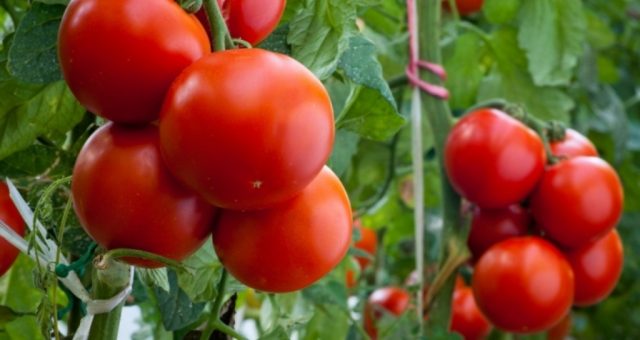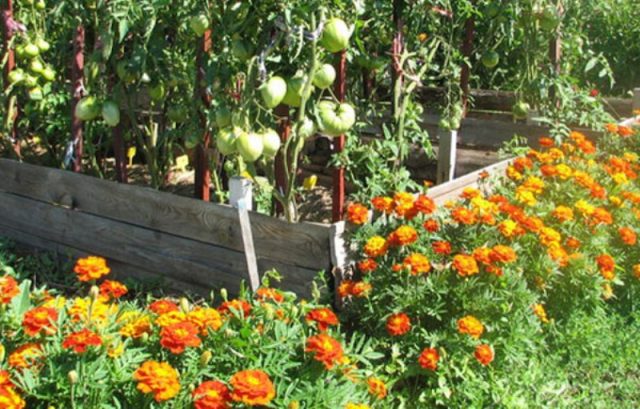Content
Tomato Nastena F1 is one of the most popular early maturing varieties. The variety received love from gardeners for a high yield, a small, compact bush and for unpretentious care. Due to its high yield, the variety is grown on an industrial scale and in summer cottages.
Detailed description of the variety
Nasten's tomatoes are an early ripe hybrid bred by Russian scientists in 2008. During the trial, the variety showed high yields and unpretentiousness, due to which the plant began to be grown on an industrial scale.
Tomato Nastena F1 is a determinant variety (growth restriction). An adult plant forms a low-leafed, powerful bush up to 1 m high. Due to the scarce dark green foliage, the bush is well ventilated, and each fruit receives the required amount of sunlight.
Tomato Nastena, according to gardeners, is an early-maturing variety. From germination to harvesting, no more than 3 months pass. The first flower cluster grows over 6 leaves, the next ones appear every 2 leaves.
Description and taste of fruits
Nastena F1 tomatoes are a high-yielding variety. Each flower cluster forms 6 to 8 juicy, tasty fruits. The fleshy, red pulp is surrounded by a dense, but thin rind, due to which the crop is well transported over long distances and has good keeping quality.
Rounded-flattened, red fruits weigh up to 300 g. Due to the small amount of seeds, the tomato variety Nastena is used for whole canning and preparation of vegetable salads.
Varietal characteristics
Nasten's tomatoes, according to gardeners, are a high-yielding variety. Subject to agrotechnical rules from 1 sq. m you can take up to 15 kg of a juicy and sweet crop. The yield is influenced not only by varietal characteristics, but also by climatic conditions. When growing tomatoes under a film cover, fruiting increases. But when growing tomatoes in open beds, the fruits grow more juicy and sweet.
Tomato variety Nastena tolerates minor climate changes and high humidity. Also, the variety has a strong immunity to late blight, alternaria and verticillosis.
To protect the tomato from the sudden addition of diseases, it is necessary to carry out preventive measures:
- observe crop rotation;
- tear off the lower leaves so that they do not touch the ground;
- carry out timely weeding;
- before planting seeds, treat the soil;
- ventilate the greenhouse more often;
- purchase only high-quality planting material.
Subject to the rules of care, the tomato is not afraid of diseases or insect pests.
Pros and cons of the variety
Tomato variety Nastena F1, judging by the reviews and photos, consists of some advantages. These include:
- high yield, the variety can be grown for sale;
- large-fruited;
- forms a low, low-leafed bush;
- good presentation and taste;
- a small number of seeds;
- unpretentious care;
- good transportability and keeping quality;
- resistance to diseases and sudden cold snaps;
- can grow in open beds and under a film cover;
- does not form stepchildren.
There were no deficiencies in the variety.
Planting and care rules
The quality and quantity of the crop depends on the correctly chosen place and the timely prepared beds. The Nastena variety is so not whimsical that novice gardeners can grow it.
Growing seedlings
It is profitable to grow the determinant Nastena variety, it is able to set fruits in any conditions. When grown in the south, seeds are sown directly into the ground, in regions with a short summer, Nasten F1 tomatoes, according to gardeners, are best grown through seedlings.
To obtain strong and healthy seedlings, it is necessary to prepare the soil and planting material. You can buy soil for planting seeds at the store, or you can prepare it at home. For this, peat and sand are mixed in a ratio of 3: 1.
To prevent an adult plant from getting sick, the seeds must go through a disinfection stage before sowing. To do this, the seed can be soaked for 10 minutes in a weak solution of potassium permanganate or in a warm solution of water and hydrogen peroxide (100 ml of water and 3 ml of peroxide).
For planting, you can use peat or plastic cups, boxes 10 cm high or peat tablets. When planting in boxes and plastic cups, the container must be scalded with boiling water.
The prepared containers are filled with nutrient soil, the seeds are spilled and buried by 1.5 cm. The crops are covered with polyethylene or glass to create a favorable microclimate for germination and removed to a warm place. After the emergence of shoots, the shelter is removed, and the seedlings are transferred to a well-lit place. Since the seeds are sown at the end of March, additional lighting must be installed.
After the appearance of 3 true leaves, the seedlings dive into separate containers of a larger volume, deepening the plant to the cotyledon leaves.
Before transplanting tomatoes to a permanent place, hardening must be carried out. To do this, the tomatoes are taken out into the open air, for the first time for 5 minutes, then increasing the residence time by 5 minutes daily.
Transplanting seedlings
Seedlings ready to plant should be 30 cm tall and have a flower cluster. Before planting, the soil is dug up, humus, wood ash and crushed eggshells are added.
On the prepared bed, holes are made at a distance of 50 cm from each other. The best predecessors for Nasten's tomato are legumes, cereals and pumpkin crops. After potatoes, peppers and eggplants, the tomato can be planted after 3 years.
The landing hole is plentifully spilled with settled, warm water. Next, the seedlings are carefully removed from the cup and planted at right angles to the ground. The plant is covered with earth, tamped, spilled and mulched. You can use straw, grass cuttings or sawdust as mulch. Mulch is an assistant to the gardener, as it:
- retains moisture;
- does not allow germination weeds;
- nourishes the soil;
- protects the root system from sunburn.
To prevent the plant from being attacked by pests, spicy herbs, calendula and marigolds can be planted next to the tomatoes.
Tomato care
Caring for a tomato of the Nastena variety is simple, it consists in watering and feeding.
The first watering with warm, settled water is carried out 2 weeks after planting the seedlings. Further, abundant irrigation is necessary:
- during flowering;
- during the formation and ripening of fruits.
Since tomatoes are a moisture-loving plant, 3 liters of water are poured under each bush. After watering, the soil is loosened and mulched.
Top dressing is necessary for Nasten's tomato to form large fruits. Fertilizers are applied during flowering, during the formation and ripening of fruits. Complex mineral and organic fertilizers are used as fertilizer.
Tomato variety Nastena greatly simplifies the work of the gardener:
- he does not form stepchildren;
- it does not need to be shaped;
- a garter is only necessary if a large number of fruits are formed on the hand.
Extra care when growing in a greenhouse:
- regular ventilation;
- adherence to temperature and humidity conditions;
- artificial pollination;
- timely removal of weeds;
- disease prevention;
- regular collection of fruits to increase fruiting.
For better fruit setting, greenhouse tomatoes need artificial pollination. To do this, they lure pollinating insects, carry out frequent airings in windy weather, shake the bush every day.
In order for the plant to receive more light, it is necessary to remove the leaves under each flower ovary. You can cut no more than 3 leaves per week.
Conclusion
Tomato Nastena F1 is a godsend for the gardener, as it is unpretentious, has no drawbacks, and is resistant to many diseases. But, despite the ideality, the variety, like any plant, requires care and timely care. With a minimum of effort and time, you can get a generous, tasty and aromatic harvest.










